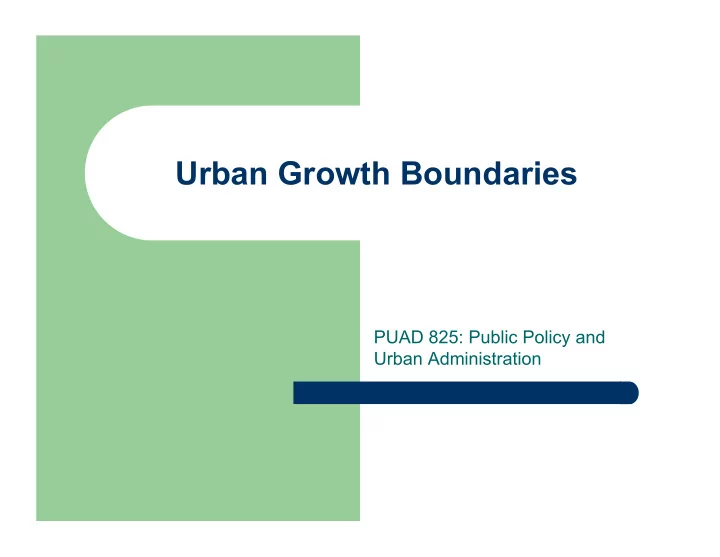

Urban Growth Boundaries PUAD 825: Public Policy and Urban Administration
Overview Urban Growth Boundary defined Why establish an UGB? Advantages of UGBs How to create UGBs UGBs around the world UGBs in Portland, OR Housing prices and UGBs Criticisms of UGBs Questions?
Other Terms for UGBs Green Belt Urban Growth Area Urban Service Area Town Boundary Village Curtilage Village Envelope
Urban Growth Boundary Defined An urban growth boundary (UGB) is a legal boundary separating urban land from rural land. UGBs attempt to control urbanization by increasing the concentration of urban development within the boundary and minimizing it outside of the boundary.
Why Establish an UGB? Two reasons… 1. Contain, control, and phase urban development. 2. Protect farmlands and other natural resources (watersheds, wildlife habitats, etc.)
Advantages of UGBs Savings taxpayers’ dollars by using public facilities more efficiently Encouraging the development of more affordable housing Stimulating community development patterns that support more accessible public transit Enabling quick open space retreats from urban centers Bringing together diverse interests (farmers, developers, environmentalists) Encouraging long-term strategic thinking Others? Taken from the Urban Growth Boundaries Brochure from the Greenbelt Alliance, San Francisco, CA
Creating an UGB in Your City Two Options Voter Approval 1. City Council Action 2. Which is better? Voter Approval: UGBs cannot be changed without another vote of community residents. Future city councils could change UGBs.
UGBs Within Multiple Jurisdictions When UGBs are proposed in areas with multiple jurisdictions, a special urban planning agency may be created by the state to manage it. – For example, consider state, city, county, and school districts.
UGBs Around the World Australia Melbourne (The Melbourne 2030 Metropolitan Strategy) – One of the world’s largest urban footprints for its population density. Adelaide Parklands – Adelaide’s central business district is entirely surrounded by this forested area as planned in 1837.
UGBs Around the World Canada Vancouver, British Columbia Ottawa Greenbelt Toronto Greenbelt (Golden Horseshoe)
UGBs Around the World United Kingdom London Metropolitan Green Belt (began in the 16 th century) The North West Green Belt South and West Yorkshire Green Belt West Midlands Green Belt
UGBs Around the World New Zealand Dunedin’s Green Belt – One of the world’s oldest. – Planned during the Otago Gold Rush in the 1860s.
UGBs Around the World United States States of Oregon, Washington, and Tennessee Minneapolis, MN Virginia Beach, VA Lexington, KY Ventura County, California Miami-Dade County, Florida Others?
Portland, OR UGB established in 1979. Contains 145.4 square miles Endorsed by the Sierra Club and the Oregon Homebuilders Association. Tried to be brought down by three ballot initiatives and each of them failed with increasing margins. Ranked number 1 on quality of life and economic factors that affect personal sustainability. (2006 US City Sustainability Ranking by SustainLane Government)
Housing Prices and UGBs Limiting the supply of developable land increases the demand for property. As the demand for property increases, so do property values. – Portland, OR example from 2004: Several thousand acres were added within the UGB to help with housing prices rising at record rates. Oregon State Law added that UGBs must include room for a 20-year supply of land.
Criticisms of UGBs “Preserve the bourgeois status quo of current residents,” Tim Hartford, economist. Existing landlords profit from housing scarcity. Limits growth. High property values keep out the poor. Limit options for commercial retail due to limited space. Others?
Questions or Comments?
Recommend
More recommend